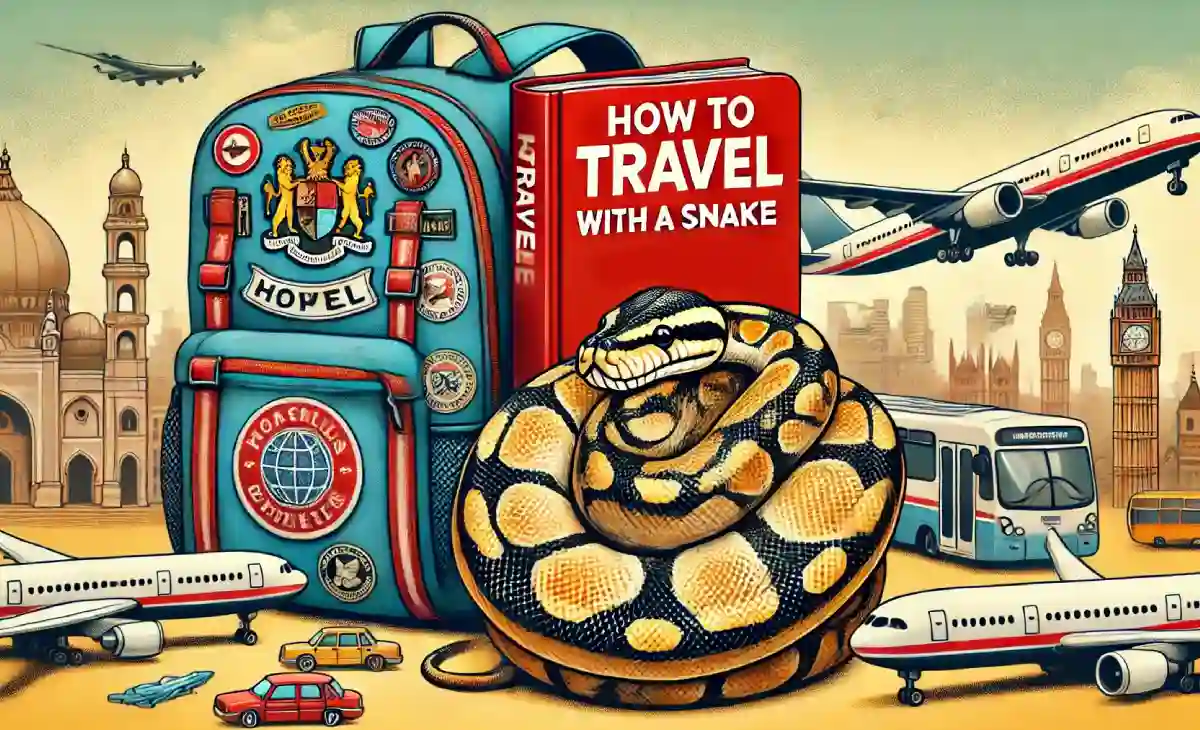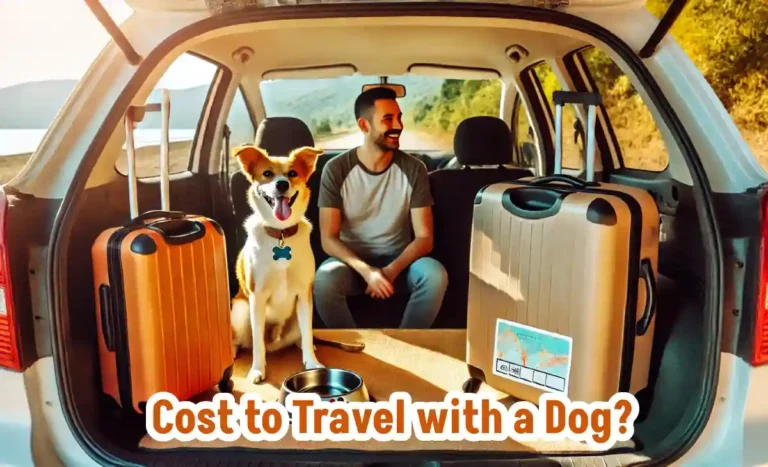Traveling with a snake might seem challenging, but with the right preparation, you can make the journey smooth and stress-free. Whether you’re relocating, taking a vacation, or visiting the vet, ensuring your snake’s safety and comfort is key.
This guide has practical tips and expert advice for traveling with your snake. It will make the trip easier for both of you. Did you know that snakes are sensitive to temperature changes? This makes careful planning very important. Let’s learn the essentials of traveling with your reptile friend.
What to Know Before Traveling with a Snake?
Before you travel with a snake, it’s important to understand their unique needs. Snakes are sensitive to temperature changes, noise, and light. Preparation is vital to keep your snake comfortable during any journey.
Make sure you have a clear understanding of your snake’s natural behavior and preferences. Know your snake’s specific needs. This will help you decide the right temperature, enclosure, and handling during travel.
Planning the Trip

Traveling with a snake requires good planning. Preparing ahead will reduce stress for both you and your pet. Consider the length of your trip, the weather conditions, and your snake’s individual needs.
Planning includes choosing the right travel container. Pack all the important supplies and be ready for emergencies. The more thoroughly you plan, the more comfortable the journey will be for your snake.
Use a Proper Travel Container:
The travel container is one of the most important parts of transporting your snake. Choose a secure, ventilated container that is not too big. A smaller container reduces the risk of injury to the snake by limiting movement during the ride.
Use a plastic tub with ventilation holes or a cloth bag inside a sturdy box. Make sure the container is escape-proof to avoid any surprises on the way. A tight-fitting lid is essential because snakes are expert escape artists. Line the container with paper towels or soft bedding to provide cushioning and absorb any waste. Make sure that the container has enough airflow to prevent overheating or suffocation.
Maintain the Right Temperature:
Snakes are cold-blooded animals and rely on external heat to regulate their body temperature. Keep the travel container warm, but not too hot. You can use heat packs, but make sure they are not in direct contact with the snake.
Wrap the heat packs in a cloth and place them near the container to provide gentle warmth. Keep an eye on the temperature throughout the journey using a thermometer. Temperature control is especially important if you’re traveling during cold weather.
Try to keep the container around your snake’s preferred temperature range. Different species have different temperature requirements, so make sure you know what is ideal for your snake. In warmer weather, ensure the container is not exposed to direct sunlight, which can lead to dangerous overheating.
Avoid Feeding Before Traveling:
It’s recommended not to feed your snake 24-48 hours before traveling. Snakes take time to digest food, and movement during travel can lead to regurgitation, which is stressful and unhealthy for them.
Instead, ensure your snake is well-fed a few days before you start your trip. This will help reduce stress and prevent any digestive issues during the journey. Snakes can go a few days without food, so it’s better to avoid feeding until the travel is complete.
Packing Essentials for Traveling with a Snake

Just like any other pet, snakes have a few essentials that need to be packed for the trip. Being prepared will ensure a safe and comfortable journey for your snake.
Travel Kit for Your Snake:
Prepare a small travel kit for your snake that includes the following:
- Heat Pack: To keep the snake warm.
- Extra Bedding: Paper towels or other bedding materials in case of a mess.
- Water Spray Bottle: Keep your snake hydrated by spraying the inside of the container lightly.
- First Aid Kit: Include basic items for emergencies, such as antiseptic wipes.
- Spare Container: In case of an emergency, having a spare travel container can be very useful.
Having these items ready will ensure you can respond to any situation that may arise during the trip. The travel kit should be easy to access throughout the journey.
Hydration During the Journey:
Snakes do not drink water often, but it is still important to ensure they do not get dehydrated during long trips. Spray the container lightly with water to maintain humidity, which helps keep your snake hydrated.
If your snake requires a more humid environment, you can place a damp cloth in the container. Make sure the container does not become too wet, as excessive moisture can cause respiratory issues.
Handling Your Snake During Travel
The way you handle your snake during the trip can make a big difference. Snakes are easily stressed by changes in their environment, and traveling can be very unsettling for them.
Limit Handling:
Snakes do not enjoy a lot of handling, especially during travel. Minimize handling to reduce stress for your snake. Keep the container in a secure spot where it won’t move around too much.
Only handle your snake if necessary, such as when transferring it from the travel container to its enclosure. Excessive handling can increase stress, leading to health issues.
If you must handle the snake, do so gently and make sure your hands are clean. Try to keep these interactions brief, as too much handling can increase the snake’s stress level. Snakes prefer dark, secure spaces, so handling them less will make them feel safer.
Keep the Environment Calm:
Snakes are sensitive to noise and sudden movements. Keep the car environment calm and quiet. Avoid loud music and sudden movements that could disturb your pet. A peaceful environment will help your snake stay calm throughout the journey.
Consider using a cover over the container to help block out light and create a secure, dark space for your snake.
Ensuring Safety When Traveling with a Snake
Safety is crucial when traveling with your snake. Here are a few safety measures to keep in mind to ensure your snake’s wellbeing throughout the trip.
Secure the Travel Container:
Place the container on a flat surface where it cannot tip over during the ride. The back seat or the car floor are usually the best places. Make sure the container is securely fastened to avoid any movement that could injure the snake.
Use seat belts or other securing methods to keep the container stable. Avoid placing the container in direct sunlight, as this can lead to overheating.
Avoid Extreme Temperatures:
Never leave your snake in a parked car. The temperature can change quickly, which is dangerous for reptiles. Plan your stops ahead of time. Make sure someone stays with the snake, or take the container with you.
Snakes are sensitive to extreme temperatures. It is important to keep a steady temperature during the trip.Avoid placing the container near air conditioning vents or direct heat sources.
A rapid change in temperature can cause shock and health problems for your snake. Keep monitoring the temperature to make sure it stays within the safe range for your specific snake species.
Post Travel Care for Your Snake
After reaching your destination, help your snake settle back into its home. The transition from traveling to its regular environment can be stressful for your snake, so it’s important to take it slow.
Allow Time to Decompress:
Once you arrive, place your snake back in its enclosure and allow it time to settle. Avoid feeding or handling for at least 24 hours to let your snake recover from the stress of travel.
Snakes need time to readjust to their environment, and giving them space will help them feel secure again. Make sure the enclosure is set up correctly with the right temperature and hiding spots.
Check for Signs of Stress:
Watch for signs of stress such as refusal to eat, excessive hiding, or unusual behavior. If these signs persist, consult a reptile vet to ensure your snake is healthy. Stress can manifest in different ways, and early intervention is key to keeping your snake in good health.Give your snake a calm and comfortable space after traveling. This helps reduce any stress it may feel.
Legal Considerations When Traveling with a Snake
Traveling with a snake may come with legal requirements, depending on your destination. It is important to be aware of any laws or regulations that may affect your ability to transport your pet.
Check Local Regulations:
Different states or countries have varying regulations on transporting reptiles. Some locations may need special permits or documents to bring your snake along. Make sure to research and follow all regulations to avoid any trouble during your trip.
In some places, certain snakes are not allowed. Not following local laws can lead to fines or having your pet taken away.
You can learn more about the regulations for traveling with reptiles by visiting official websites like this one. Always carry the needed paperwork when you travel. This includes health certificates or permits. It will help you have a smooth journey.
Conclusion
Traveling with a snake can be stress-free if you plan properly and prioritize your pet’s needs. Choose the right container, maintain temperature, limit handling, and ensure a calm environment. By taking these steps, you and your snake can have a safe journey.
If you have any doubts, consult with a reptile vet before starting your trip. Remember that preparation and attention to detail are key when it comes to traveling with your snake.
FAQs
Can I use a heat lamp while traveling with my snake?
No, using a heat lamp while traveling is not practical or safe. Instead, use heat packs to maintain the proper temperature inside the travel container.
How long can a snake stay in a travel container?
A snake can stay in a travel container for many hours. Make sure the temperature is right and the container is safe. But, try to minimize travel time as much as possible.
Should I feed my snake right after traveling?
No, it’s best to wait at least 24 hours before feeding your snake after traveling. This allows your pet to settle down and reduces the risk of regurgitation.
Can I travel with a snake on a plane?
Yes, but you need to check with the airline beforehand. Some airlines have strict rules for carrying reptiles. You may need to follow special requirements to bring your snake on the plane.
How do I know if my snake is stressed during travel?
Signs of stress in snakes include restlessness, hissing, and refusal to eat. If you notice these signs, try to create a calmer environment for your snake.




